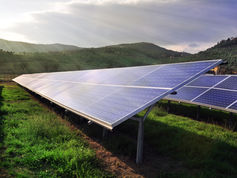Virginia's Solar Energy Push
- Otto Gunderson

- Mar 12
- 2 min read
Updated: Mar 14
The power demand increases in Virginia, primarily driven by the creation of data centers, have led to an ever-increasing call for renewable power generation. The State of Virginia has taken active measures to champion renewable energy efforts. Signed into law in 2020, the Virginia Clean Economy Act requires that all electricity in Virginia be produced from carbon-free sources by 2050. Along with economic growth from both utility-scale and distributed generation, the Solar Energy Industries Association (SEIA) reported that this new policy will create up to 29,000 jobs in the solar industry.

Virginia has a dominant role in this market, with over 70% of world internet traffic running through Northern Virginia. Virginia officials purposefully decided to make the area an attractive location for large data centers by exempting them from sales and use taxes. This has led to rapid growth in demand for energy in Virginia. Renewable projects, including solar, will be called upon to provide significant energy to compensate.
The development of the Rivanna solar project in Charlottesville, Virginia, has proven the possibility of large-scale solar projects. The completed 14.6 MW project is capable of producing over 20,000 MW/h of solar energy per year and can successfully power thousands of homes and businesses. Virginia will also reap the financial benefits of the transition to renewable energy. In the case of the Rivanna project, this will mean 150 local jobs during construction and development and 2 MM in state and local taxes over the system's life.
This may lead to pressure being placed on the state’s two major investor-owned utilities: Dominion Energy and Appalachian Power Company. These utilities will likely continue to invest heavily in renewable energy projects to make up for the carbon-emitting facilities that will be closed over the next 3 decades. While in 2022, solar energy produced only 5% of Virginia’s energy demand, this has shifted recently, with the energy rate reaching 13% of power generation by 2024. The Rivanna project is just one example of the sizeable solar production facilities anticipated to come online by 2035.
In conversation with Zack Zoller, the VP of Engineering, Procurement, & Construction at Adapture Renewables, he mentioned the juxtaposition of residents across Mid-Atlantic states that came from wanting to see renewables expand in the area without wanting them to cause disruption to residents. This can lead to delays in permitting time as communities assess the project's possible effects.

One critical aspect of making solar farms palatable to residents is to plan for decommissioning on the front end. Solar projects such as the Rivanna farm have a rough horizon of 35 years, while flexibility exists to take advantage of more efficient panels in the future. Once the system is decommissioned, it will return to being a timber farm, albeit a more efficient one, as the soil has had 3 decades to replenish. This ability to provide a strong end-of-life solution for renewable projects reduces concerns about the impact of solar projects in communities.













Comments